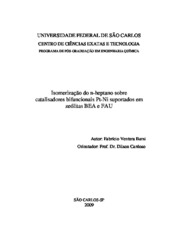| dc.contributor.author | Barsi, Fabrício Ventura | |
| dc.date.accessioned | 2016-06-02T19:55:26Z | |
| dc.date.available | 2010-02-12 | |
| dc.date.available | 2016-06-02T19:55:26Z | |
| dc.date.issued | 2009-12-09 | |
| dc.identifier.citation | BARSI, Fabrício Ventura. Isomerização do n-heptano sobre catalisadores bifuncionais Pt-Ni suportados em zeólitas BEA e FAU. 2009. 150 f. Tese (Doutorado em Ciências Exatas e da Terra) - Universidade Federal de São Carlos, São Carlos, 2009. | por |
| dc.identifier.uri | https://repositorio.ufscar.br/handle/ufscar/3879 | |
| dc.description.abstract | The objective of this paper was to study the influence of metal loading content on the properties of bimetallic catalysts, formed by Pt and Ni, supported on zeolite HUSY and HBEA. Another objective of this study was to infer possible mechanisms and reaction pathways. In this sense, were compared catalysts containing different contents and percentage of metals in the isomerization of n-heptane and characterized by transmission electron microscopy (TEM), scanning electron microscopy (SEM), hydrogen chemisorption, temperature-programmed reduction (TPR). The results show that the catalyst with the total metal content of 180 μmol of Me.gcat -1 was the most active, suggesting that there is an optimum relationship between acid sites and metallic sites. The increase in total metal content of the solid from this value decreases the activity of the same, possibly due to decreased dispersion of metallic phase in the catalyst. In this content, the activity increases with the percentage of platinum, until the value of 50%. Increasing the percentage of platinum above this value, there is a slight decrease in activity of the catalyst. The catalysts with higher activity were almost 100% selective to the isomerization reaction. Through TEM and chemisorption of H2 there was a better metal dispersion on the catalyst 50Pt50Ni/HBEA with 180 μmol of Me.gcat -1 in agreement with the catalytic results. By EDX analysis performed during the characterization by scanning electron microscopy verified the presence of nickel, which was not found by EDX analysis in transmission electron microscopy, indicating that this element (metal or cationic) is dispersed in the zeolite matrix. The results of TPR, there was a greater reduction of Ni2+ ions when it is in the presence of Pt, evidenced by the shift reduction peak to lower temperatures in front of the bimetallic catalysts monometallic. The results also showed that the process of rapid reduction has not reduced completely cations Pt2+ and Ni2+ in the catalysts. It was realized a study of the influence of contact time of reagents (nhexane and n-heptane) with the catalyst and also the isomerization of 2-methylhexane in order to study the mechanism of isomerization. | eng |
| dc.description.sponsorship | Financiadora de Estudos e Projetos | |
| dc.format | application/pdf | por |
| dc.language | por | por |
| dc.publisher | Universidade Federal de São Carlos | por |
| dc.rights | Acesso Aberto | por |
| dc.subject | Catálise | por |
| dc.subject | Catalisadores bimetálicos | por |
| dc.subject | Zeólita | por |
| dc.subject | Isomerização | por |
| dc.title | Isomerização do n-heptano sobre catalisadores bifuncionais Pt-Ni suportados em zeólitas BEA e FAU | por |
| dc.type | Tese | por |
| dc.contributor.advisor1 | Cardoso, Dilson | |
| dc.contributor.advisor1Lattes | http://lattes.cnpq.br/2462847535959232 | por |
| dc.description.resumo | O objetivo deste trabalho foi verificar a influência da carga metálica nas propriedades de catalisadores bimetálicos, formados por Pt e Ni, suportados na zeólita HUSY e HBEA. Outro objetivo desse trabalho foi o de inferir possíveis mecanismos e caminhos de reação. Nesse sentido, foram comparados catalisadores que contenham diferentes teores molares e diferentes proporções dos metais, na reação de isomerização de n-heptano e caracterizados por microscopia eletrônica de transmissão (MET), microscopia eletrônica de varredura (MEV), quimissorção de hidrogênio, redução à temperatura programada (RTP). Os resultados mostram que o catalisador com teor metálico de 180 μmol de Me.gcat -1 foi o mais ativo, sugerindo que existe uma relação ótima entre sítios ácidos e sítios metálicos. O aumento do teor de metal no sólido a partir desse valor diminui a atividade do mesmo, possivelmente devido à diminuição da dispersão da fase metálica no catalisador. Neste, a atividade aumenta com a porcentagem de platina, até o valor de 50%. Aumentando a porcentagem de platina acima desse valor, há uma ligeira diminuição na atividade do catalisador. Os catalisadores com maior atividade foram praticamente 100% seletivos à reação de isomerização. Através de MET e quimissorção de H2 verificou-se uma melhor dispersão metálica no catalisador 50Pt50Ni/HBEA com 180 μmol de Me.gcat -1 concordando com os resultados catalíticos. Por análise EDX realizada durante a caracterização por microscopia eletrônica de varredura verificou-se a presença do níquel, que não foi encontrado pela análise de EDX na microscopia eletrônica de transmissão, indicando que esse elemento (metálico ou catiônico) está disperso na matriz zeolítica. Nos resultados de RTP, verificou-se uma maior redutibilidade dos cátions Ni2+ quando este está na presença da Pt, evidenciado pelo deslocamento do pico de redução para menores temperaturas nos catalisadores bimetálicos frente aos monometálicos. Os resultados mostraram também que o processo de redução rápida não reduziu completamente os cátions Pt2+ e Ni2+ nos catalisadores. Realizou-se ainda um estudo da influência do tempo de contato dos reagentes (n-hexano e n-heptano) com o catalisador e também a isomerização do 2-metil-hexano visando o estudo do mecanismo da isomerização. | por |
| dc.publisher.country | BR | por |
| dc.publisher.initials | UFSCar | por |
| dc.publisher.program | Programa de Pós-Graduação em Engenharia Química - PPGEQ | por |
| dc.subject.cnpq | ENGENHARIAS::ENGENHARIA QUIMICA | por |
| dc.contributor.authorlattes | http://lattes.cnpq.br/7635533390888747 | por |
